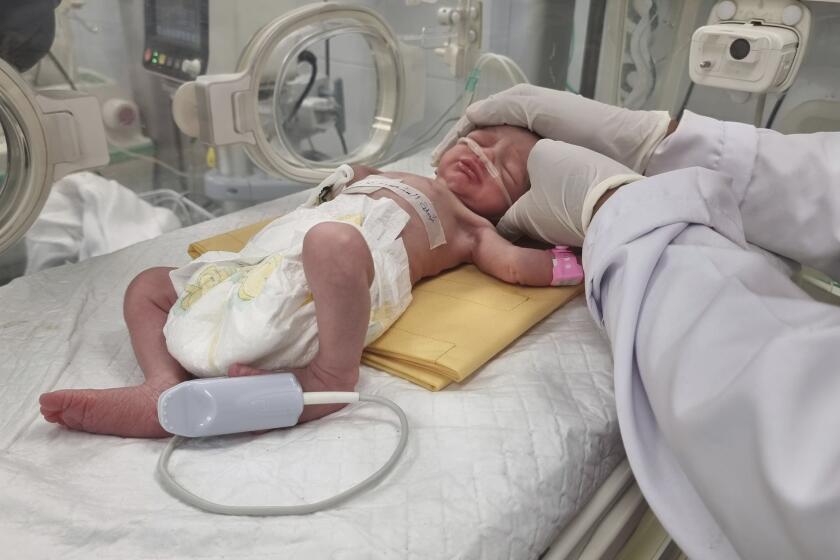Katrina Killed Across Class Lines
The bodies of New Orleans residents killed by Hurricane Katrina were almost as likely to be recovered from middle-class neighborhoods as from the city’s poorer districts, such as the Lower 9th Ward, according to a Times analysis of data released by the state of Louisiana.
The analysis contradicts what swiftly became conventional wisdom in the days after the storm hit -- that it was the city’s poorest African American residents who bore the brunt of the hurricane. Slightly more than half of the bodies were found in the city’s poorer neighborhoods, with the remainder scattered throughout middle-class and even some richer districts.
“The fascinating thing is that it’s so spread out,” said Joachim Singelmann, director of the Louisiana Population Data Center at Louisiana State University. “It’s not just the Lower 9th Ward or New Orleans East, which everybody has heard about. It’s across the board, including some well-to-do neighborhoods.”
Because New Orleans was one of the nation’s poorest cities, where more than one in four residents lives below the poverty level, many of the victims were still found in neighborhoods that were impoverished by national standards. But by the standards of New Orleans, those neighborhoods were economically stable, and deaths citywide were distributed with only a slight bias for economic status.
Of the 828 bodies found in New Orleans after the storm, 300 were either recovered from medical facilities or shelters that offer no data on the victim’s socioeconomic status, or from locations that the state cannot fully identify. Of the 528 bodies recovered from identifiable addresses in city neighborhoods, 230 came from areas that had household incomes above the citywide median of $27,133. The poorer areas accounted for 298 bodies.
The state official in charge of identifying Katrina’s victims, Dr. Louis Cataldie, said he was not surprised by the findings. “We went into $1-million and $2-million homes trying to retrieve people,” he said.
The information used in The Times analysis was incomplete, due to difficulties in gathering data in the days after Katrina struck and to bureaucratic problems that followed.
The private company that was contracted to collect bodies was supposed to mark the GPS coordinates of each recovery, but state officials said they soon determined that data was “worthless.” They had to reconstruct the locations where bodies were found but in some cases could provide information no more specific than “Canal Street.” Although it is the most comprehensive data they have released on storm fatalities, state officials acknowledge that the information is still riddled with errors and probably will be corrected constantly in coming months.
The state data also include locations such as the interchange of I-10 and I-610 where rescuers in motorboats were directed to deposit bodies they found floating in the floodwaters. There is no way to determine where some of those 19 bodies came from, and all have been excluded from The Times analysis.
“The data you have leaves a lot to be desired,” Cataldie said in an interview Friday. “I don’t know if it’ll ever be 100%.”
Of the 1,095 people killed by Katrina in Louisiana, the state has formally identified and released demographic data on 535. Many other victims are tentatively identified, though 93 remain unidentifiable. A couple of bodies are recovered every week, and officials say other victims may have been swept into the Gulf of Mexico, never to be found.
Medical and dental records were destroyed by the storm, and many corpses are so severely decomposed that traditional identification methods such as fingerprints are useless.
Even with the majority of the bodies identified, the state is unable to determine when most died, or how. Many death certificates bear the date of Katrina’s landfall -- Aug. 29 -- even though the victim could have died days later. Given the severity of damage suffered by bodies in the floodwaters, cause of death is also extremely difficult to determine and will never be known for many victims, Cataldie said.
New Orleans was the site of most of Katrina’s fatalities; the state reported that 76% of storm deaths statewide occurred in the city. Of the 380 bodies from New Orleans that have been formally identified, a moderately disproportionate number are white. New Orleans’ population was 28% white, yet 33% of the identified victims in the city are white and 67% black.
“The affected population is more multiracial, multiethnic and multicultural than one might discern from national media reports,” said Richard Campanella, a Tulane University geographer who has studied which parts of the city were hit the worst by flooding. His research showed that predominantly white districts in the city were almost as likely to flood as predominantly black ones.
Campanella said he was not surprised at the even distribution of bodies between the city’s poorer and more affluent neighborhoods. He noted that 70% of the identified Katrina victims in New Orleans were older than 60, frequently lifelong residents who had ridden out other hurricanes and refused to evacuate. Elderly people are more likely to be wealthier and to live in wealthier neighborhoods.
Many of the city’s wealthier neighborhoods sit on Lake Pontchartrain in the lowest-lying sector of town, Campanella said. For example, Lakeview, a predominately white neighborhood that contains mansions valued at more than $1 million in addition to crowded streets studded with modest bungalows, fronts the lake and is adjacent to the 17th Street Canal. When the levee collapsed, the neighborhood was destroyed. The only neighborhood with comparable destruction, the Lower 9th Ward, sits on higher ground but was unluckily flanked by two broken levees.
Katrina “really knew no bounds,” said Ashley Casey, an aide to Lakeview Councilman John Batt. “I don’t think it’s over yet in any neighborhood.”
Singelmann, of the Louisiana Population Data Center, said New Orleans was unique among American cities because, despite pockets of poverty in places such as the Lower 9th Ward, the city was remarkable for its integration of blacks and whites of different incomes living in close proximity.
He cited Read Boulevard East, a neighborhood of expensive new homes clustered around a 36-acre lake, as well as streets of more modest homes owned by middle-class whites and blacks. The data indicate a high concentration of recovered bodies from the neighborhood.
On the other hand, Singelmann said, poor African American neighborhoods that straddle the prosperous Garden District show a much higher concentration of recovered bodies than the Garden District itself. One reason, he said, may be that low-income residents lacked cars to flee in or the resources to pay for a safe refuge outside the city. And the Garden District sits on some of the city’s highest land.
Not all white residents who died in the storm were well-to-do; not all African American victims were poor.
William S. Porter Jr., a 75-year-old African American, for instance, worked as an embalmer and funeral director for a New Orleans funeral home.
He died at a home in the rapidly gentrifying Gentilly neighborhood during the storm -- not because he lacked the means to flee but because he refused to leave, his son said.
Porter, who called himself “the Bishop,” owned a home in the Lower 9th Ward but was moving into a second home in Gentilly.
Porter earned about $40,000 a year, said his boss, Cal Johnson of Littlejohn’s Funeral Home. He also earned rental income from two homes he owned in the Lower 9th Ward, his son said.
“He was not a pauper by any means,” Johnson said of Porter. “He lived quite well.”
Times staff researcher Maloy Moore contributed to this report.
More to Read
Start your day right
Sign up for Essential California for news, features and recommendations from the L.A. Times and beyond in your inbox six days a week.
You may occasionally receive promotional content from the Los Angeles Times.







